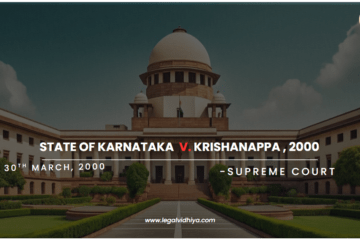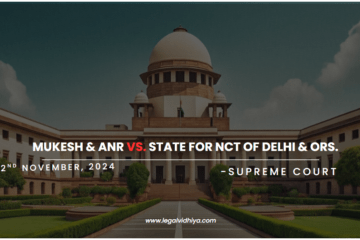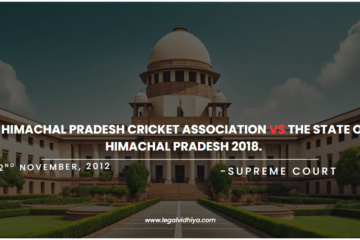
| Citation | 2022 SCC Online SC 1701 |
| Date of Adjudication | 9th December, 2022 |
| Court | The Honourable Supreme Court of India |
| Case Type | Motor Vehicles Act |
| Appellant | Mohd. Sabeer @ Shabir Hussain |
| Respondent | Regional Manager, U.P. State Road Transport Corporation |
| Bench | Justice Krishna Murari and Justice V. Ramasubramanian |
Facts of the Case
The Appellant, Shabir Hussain, identified as a scrap dealer, was on a journey in a bus, from his hometown in Gajrola, to his residence in Delhi. The bus driver, who is the Respondent in this case, was operating the vehicle recklessly and carelessly, owing to which, the bus collided with a stationary tempo. This collision resulted in severe injuries to the Appellant all over his body.
The Appellant was 37 years old when the accident occurred with a monthly income of Rs.10,000/-. As per the Disability Certificate, he now experienced a permanent disability of 70%, particularly affecting his lower right limb, among other injuries. Following the accident, a claim petition was filed with the Motor Accident Claims Tribunal, New Delhi (henceforth, MACT), seeking compensation of 20 lakhs. The MACT, reviewed the evidence and the relevant issues in the case, and determined that the Respondent was indeed guilty of reckless and negligent driving that led to the mishap. As a result, the Appellant was granted a compensation of approximately 15.7 lakhs, in addition to an annual interest rate of 7.5%.
Subsequently, an appeal was pursued in the High Court of Delhi (henceforth, HC), by the Appellant asserting that the MACT had not adequately considered the loss of earning capacity, future prospects, and had incorrectly calculated his disability. The HC, as a result, modified the award with an increase in the compensation to approximately 16.8 lakhs , accompanied by a 9% annual interest rate, following which, a Review Petition was submitted, aiming to increase the compensation to 20 lakhs/-. However, the review petition was rejected, with the HC affirming the judgment delivered in the appeal. Dissatisfied, the matter was taken to the Hon’ble Supreme Court by filing the current Civil Appeal.
Issues
In the Hon’ble Supreme Court of India, following issues was raised:
- Whether or not has the HC determined the amount to be awarded for future potential earnings in the compensation provided?
- Whether or not has the HC reasonably determined the quantum of damages to be awarded for acquiring and upkeeping the prosthetic limb?
- Are the non-pecuniary damages granted by the Learned Tribunal adequate?
Arguments of the Appellant
The learned counsel of the Appellant argued that the HC erroneously evaluated the Appellant’s income loss caused by the disability at only 35%, despite the medical board determining the permanent disability to be 70%. Since his income assessment relied on documentary evidence, it was contended that he should have been granted potential future earnings amounting to 50%. Further, it was argued that the damages provided for the acquisition, and upkeep of the prosthetic limb is insufficient, as cost of the limb alone amounts to 2.6 lakhs, and also requires repairs every 6 months, which incur a heavy cost. Since the Appellant is only 37 years old and will need the leg for his entire life, the existing damages falls short. Furthermore, it was contended before the Hon’ble Supreme Court that the non-pecuniary damages awarded are also inadequate and insufficient.
Arguments of the Respondent
The learned counsel for the Respondents argued that the HC has correctly assessed the functional disability at 35% regarding the lower limb amputation. Furthermore, the HC has already raised the estimated future income loss from approximately 6 lakhs to around 6.7 lakhs, and has also increased the sum allocated for transportation expenses to 400% of it was before. The award for potential future earnings has been rightly denied, considering that the Appellant’s income, as indicated by the Income Tax Returns, has increased despite the disability. Further, as the Appellant works as a scrap dealer from a fixed location, requiring minimal physical movement for his work, the disability does not significantly impact his ability to earn.
Adjudication by the Hon’ble Supreme Court
The Supreme Court, relying on Sandeep Khanuja v. Atul Dande and Anr. and Raj Kumar v. Ajay Kumar and Anr., held that it is an established legal principle that in situations involving permanent disability resulting from a motor accident, the injured party is entitled to receive damages not only for the anticipated future income loss but also for the potential future opportunities. That “just compensation” should be construed to restore the claimant to the same status they held before the accident occurred, has been reiterated by the Court at several instances, already. The Court further highlighted that even if the Appellant’s income had risen after the accident, it should not be used as a basis for disqualifying him from seeking damages for potential future earnings, as the increase could be linked to various other causes.
Based on the present damages provided for the artificial leg and its upkeep, the Supreme Court held that the Appellant would require a new limb after just 15 years, even without considering the possibility of replacements. Since when the accident occurred, he was only 37 years old, and it is reasonable to assume that he would live until the age of 70 or even longer, it is imperative to ensure that he receives sufficient compensation for the procurement and upkeep of three prosthetic limbs atleast till he reaches the age of 70.
Furthermore, given the enduring nature of the disability and its impact on the Appellant’s life, the Supreme Court held that the damages awarded by the HC for non-monetary aspects are not adequate, as while awarding damages in instances of permanent disability, the case should be examined in its entirety, taking into consideration the social and economic circumstances of the claimants as well.
In the present case, since the Appellant hailed from a financially disadvantaged segment of society, the claimant was eligible to receive compensation amounting to approximately 38.7 lakhs, in addition to an annual interest rate of 9% starting from the date of the application.
Written by Aarya Dubey an intern under legal vidhiya
Disclaimer: The materials provided herein are intended solely for informational purposes. Accessing or using the site or the materials does not establish an attorney-client relationship. The information presented on this site is not to be construed as legal or professional advice, and it should not be relied upon for such purposes or used as a substitute for advice from a licensed attorney in your state. Additionally, the viewpoint presented by the author is of a personal nature




0 Comments